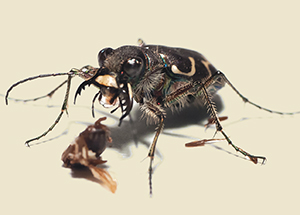The Tiger Beetle: Too Fast to See
Speed is an asset for a predator. Except when that predator runs so fast that it essentially blinds itself.
The tiger beetle, relative to its size, is the fastest creature on Earth. Some of these half-inch-long beetles cover about 120 body lengths per second (at about five miles per hour). The fastest human can do about five body lengths. To take the sprinting gold from the tiger beetle, a person would have to hit 480 miles per hour.

BUT! The tiger beetle has a problem. At peak speeds, everything becomes a blur. They can’t gather enough light with their eyes, and vision is compromised. It can still perceive the pursued but not at all clearly.
The University of Pittsburgh’s Daniel Zurek, a postdoctoral researcher in Nathan Morehouse’s lab in the Department of Biological Sciences in the Kenneth P. Dietrich School of Arts and Sciences, is looking into how the tiger beetle’s speed-related vision issues correlate with when it opens and closes its vicious mandibles in pursuit of supper.
Is it just guessing? Hoping that its Jaws of Death are ready to crush prey when it inevitably catches up?
No, Zurek says in a paper published Nov. 5 in Biology Letters.
“We’re asking in what situations do the mandibles open and close,” Zurek says. “They’re trying to catch something, so they want to be sure that their jaws are open and close on contact.” But, he adds, in their obstacle-riddled habitat, it’s probably not a good idea to keep them open all the time, lest the mandibles snag something, delaying the beetle and permitting escape.
“Is it a matter of distance [to prey], the size [the prey] appears on the retina, the projected time to collision? There are lots of variables,” he says.
Using a dummy piece of prey (a plastic bead on a string), Zurek let the beetles give chase and recorded their hunting efforts in super slow-mo. As the beetle begins to catch up to the escaping dummy prey, the contracting image of the prey as perceived by the beetle begins to expand, which is the cue for the beetle to open its jaws, Zurek found. And as the image begins to recede, the jaws close.
This research, Zurek says, reveals a novel and potentially widespread mechanism for how behavioral decisions can be made based on visual “rules” in dynamic situations, where both the observer and the target are moving.
Other Stories From This Issue
On the Freedom Road

Follow a group of Pitt students on the Returning to the Roots of Civil Rights bus tour, a nine-day, 2,300-mile journey crisscrossing five states.
Day 1: The Awakening
Day 2: Deep Impressions
Day 3: Music, Montgomery, and More
Day 4: Looking Back, Looking Forward
Day 5: Learning to Remember
Day 6: The Mountaintop
Day 7: Slavery and Beyond
Day 8: Lessons to Bring Home
Day 9: Final Lessons

